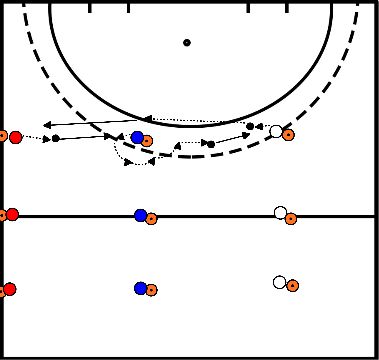Hockey drills
- A runs around the pawns with the ball and pushes to B
- B passes to C
- C drives around the pawns into the circle and passes to B who has run into the circle
- Defender D comes into action B and C try to score
Option 1: Extra defender and A attacks with him.
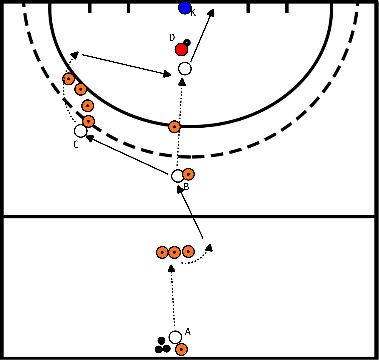
- A pushes to B
- B passes to C
- C drives around the pawns into the circle
- C rounds on goal
Option 1: B runs into the circle and gets the ball from C and rounds on goal.
Option 2: additional player D stands at the second post and tips in.
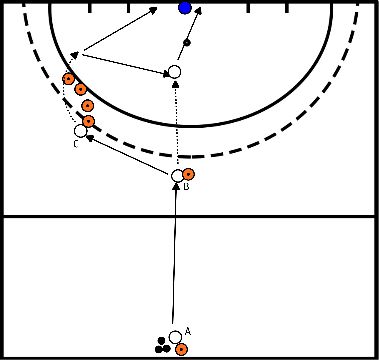
- A plays the ball to B
- B plays the ball to C
- C plays the ball to D
- D dribbles into the circle and finishes on goal
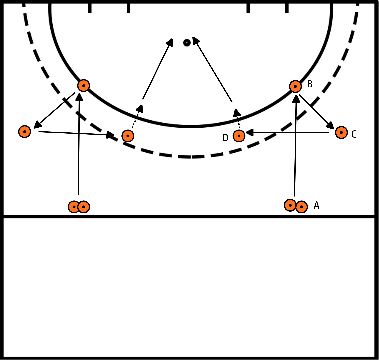
- A plays the ball to B
- B plays the ball to C who has run up to the green pawns
- C runs along the pawn line and passes the ball to A who has run through to the circle
- A then finishes on goal
You can perform this exercise on both sides.
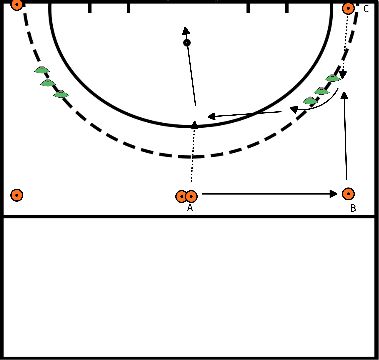
- A starts with the ball and runs a bit and passes the ball to B
- B takes possession, runs a short distance and passes to C
- C takes the ball, runs a short distance and passes the ball to A who has passed on
- A takes the ball and runs to the pawns where she makes a passing move
- C runs to the circle and gets the ball back from A
- C rounds on goal
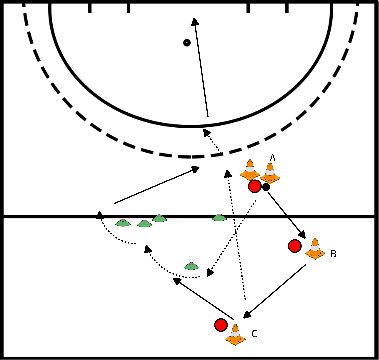
- A starts with the ball
- B runs in and gets the ball from A
- B takes the ball strongly and turns away past the pawns. Keep the ball on the stick.
- C runs in and takes the ball strongly.
- B runs through and gets the ball back from C. This may be a rebound as long as it is hard and clean.
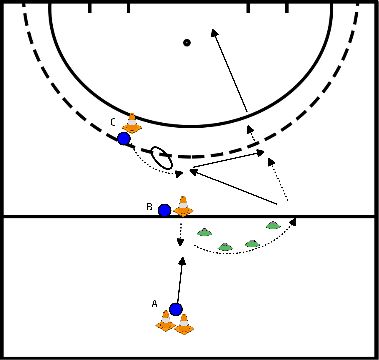
- Use pilons to set up two squares
- Around the dotted head circle (left and right next to/opposite the goal)
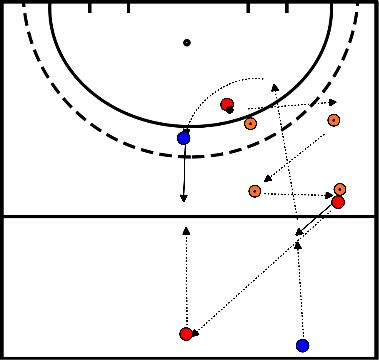
- Put out the pilons as shown in figure three, distribute the balls over pilons C and D.
- In this exercise you place one player each at pilons C and D, the rest of the team will line up at pilon A.
- From A the player runs around the pilon, from the pilon the player makes a sideways movement facing the ball (facing C).
- Player C plays the ball in the forehand of A, A takes the ball and opens to the right, runs towards the circle and finishes at goal.
- From here, he runs towards D and receives another ball.
- The player spins open to the left and finishes on goal again.
- Put out six pilons in a row with +/- five meters between each pilon.
- This is best done on the 23 meter line as shown in figure 1.
- Again make two rows and let the team sprint from the sideline to the first pylon and back, then from the sideline to the second pylon and back.
- Repeat this until the sixth pylon.
- After these sprint exercises let the team run half a lap.
Aim:
- To become physically as well as technically warm as preparation for the training.
Design:
- The exercise will be done with a maximum of 4 people.
- Of course you can put a multiple of these so that the exercise still works.
- The players 1 start with the ball and play it to their players 2. Then they change positions.
- Players 2 play the ball back to players 1 and also change positions.
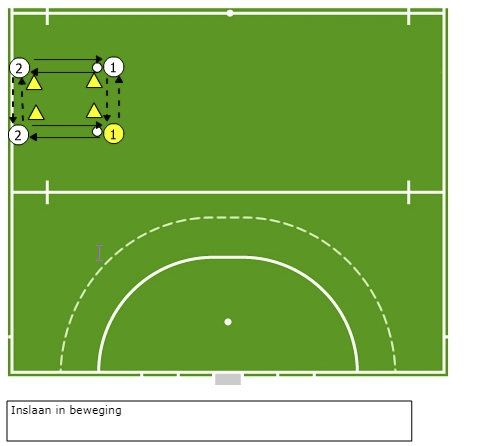
Variations:
- You can vary the way of passing (hitting, push, flats)
- Increase the distance between the pilons so that one only has to walk further.
- Increase the distance between the pilons so that one only has to move on.
- Increase both distances.
- Increase speed
- Make as many successful passes as possible in time.
Points of attention:
- Sit low for good control.
- Stick to the ground at ball control.
- Play ball on the forehand side.
- Stand still at ball acceptance.
Passing and scoring
- Each pilon has a player on it.
- Player A plays wide to the left to player B and chases the ball.
- Player B plays the ball diagonally to the right to player C and chases the ball
- Player C plays wide to the left to player D and chases the ball
- Player D plays diagonally to the right the ball to player E and chases after the ball
- Player E takes on and scores with flat / stroke
- Player E continues to the left around the extra pilons (out of practice) back to position A
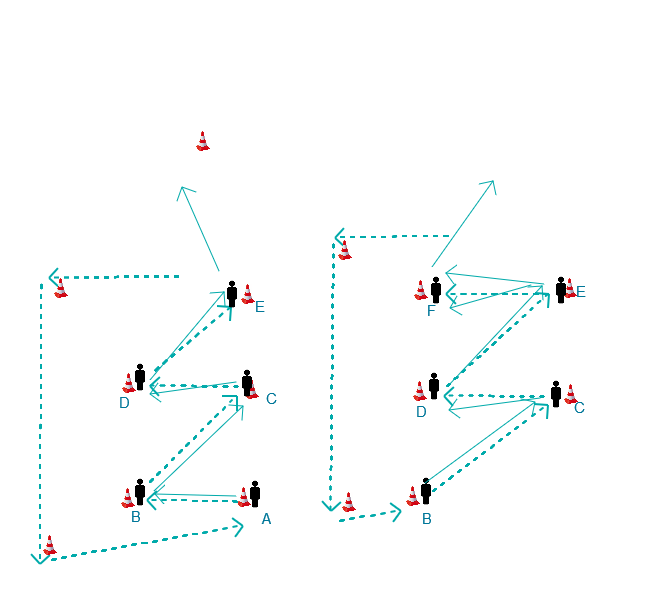
Variation:
- Balls start on the left from position B (pilon/position A is omitted), before that a pilon is added to the edge circle (position F).
- player 1 plays the ball from position B diagonally to the right to player 2 at position C and chases the ball
- Player on C plays wide to left to player in position D and chases after the ball
- Player in position D plays the ball diagonally to the right to player E and chases after the ball
- Player in position E plays wide to the left to player in position F and chases the ball
- Player in position F takes on the fh or high bh and scores with a (backhand) stroke and
- Runs outside the exercise to start position (B)
Variation 2:
- 2 rows of players behind pilons A and B
- Player 1 plays the ball wide to the left and runs straight to position C
- player 2 takes the ball and plays player 1 diagonally to the right in the fh while running (towards position C) and runs straight ahead towards position D.
- player 1 takes the ball in the fh around position C and plays the ball wide / backwards back to player 2 (towards position D) and runs to position E
- player 2 takes the ball (preferably with fh) and with foot position in direction E and plays the ball diagonally forward back to player 1 (direction E: rather just in the circle / edge circle than behind player 1)
- player 1 takes on and strikes / fats as fast as possible towards goal (do not bring the ball back) and runs outside exercise back to position B
Variation on 2:
- After that player 2 has delivered the ball to player 1 the 2nd time / last time, he / she becomes (passive) defender at the next set
- the defender is not allowed to go into the circle (or rather not even behind the line (position C/D) from where he/she started (position D)
- takes off the ball then floats over a line between position A and B.
- The 2 players that come up stay inside the box (width of pass lines) but are free in construction, they may also cross behind, cross over but no passes in the air (no lifts).
- the No. 1 scores and, just like the defender, runs outside back to another position. The No. 2 becomes defender
Accents:
- hands apart while controlling
- foot positioning open
- control it for a follow-up pass or even a quick bounce back
- Score after 2 contacts (control, max 1 other touch)
- see hands/feet position/distance from the ball at hitting and flats accents
- Player 1 plays in hard to player 2 with flats.
- Player 2 runs in on the ball, takes the ball in stride and turns left or right.
- Player 2 plays the ball in to player number 3 with a hard push.
- Player 2 then runs to pawn number 3 without the ball.
- Player number 3 accepts the ball in the run and runs on to pawn 2.
- Player number 3 hits a regular high shot to player 1.
- Player #1 takes the ball in the run and then plays another flats on the player at the pawn.
